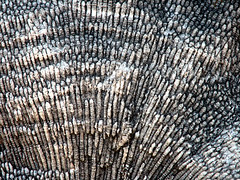 Julian is hosting this month's Accretionary Wedge, and wants us all to discuss a geologic event that's significant to us personally. (Well, technically, he asked for the event that is most significant, but I love all my pet geologic events equally, so there, nyah.)
Julian is hosting this month's Accretionary Wedge, and wants us all to discuss a geologic event that's significant to us personally. (Well, technically, he asked for the event that is most significant, but I love all my pet geologic events equally, so there, nyah.)
The nearly record-setting floods on the Mississippi River this spring have brought back memories of the summer when it just. kept. raining. During a rare break in the weather in July 1993, my mother took me, my sister, and friends up to the local Army Corps flood control structure, and the Coralville Lake behind it; of course, we got rained out. On the way back, though, we passed the dam's emergency spillway... and it was spilling!
 The lake didn't fall back below the spillway for another month. During the flood, the Iowa River swept off fifteen feet of topsoil and flood plain deposits, and began cutting in to the 375 million year old sea floor underneath. When the water finally receded, it exposed a whole ecosystem, corals and crinoids and brachiopods with the occasional primitive fish.
The lake didn't fall back below the spillway for another month. During the flood, the Iowa River swept off fifteen feet of topsoil and flood plain deposits, and began cutting in to the 375 million year old sea floor underneath. When the water finally receded, it exposed a whole ecosystem, corals and crinoids and brachiopods with the occasional primitive fish.
The path from the spillway to the river has been turned into a paleontological exploratorium. Some of the better fossils are marked, but most of them are left for visitors to discover themselves with the aid of fossil identification guides posted near the parking lot.
Watching the river flow over the dam didn't turn me into a geologist, but seeing the river swallow so many roads and buildings that summer did give me a deep appreciation of what it means to live on a flood plain. Lots of people do, in Iowa City; most of the time they enjoy lovely river views.
- Log in to post comments
As a kid I spent endless hours digging fossils out of the old quarry by N. Riverside Drive. The University had a wonderful geological museum back then that was open to the public - does it still?
...
Ahh, the flood(s) of '93. Remember them well.
The spillway at the Saylorville Reservoir here in central Iowa also had that 'sweeping off' phenomenon that exposed similar ancient rock layers. Not sure if it has been 'marked' as you describe the Coralville Reservoir.
It is indeed awesome to witness the power of Mother Nature and man's futile efforts to hold her back.
...tom...
.
I don't know what's up with the geology museum these days. My strongest UI-museum memories from when I was a kid are of the bird dioramas and the giant sloth (especially the giant sloth!) in Iowa Hall... I haven't been since high school, but man, that museum is old school! The setup at Fossil Gorge is much better from a pedagogical perspective, I think.
That's really cool. The floods of 1993 had a direct impact on my career trajectory...they taught me that not all geology was about flat-lying sedimentary rocks from the Paleozoic.
http://www.uiowa.edu/~geology/paleo/
Great link - thanks!